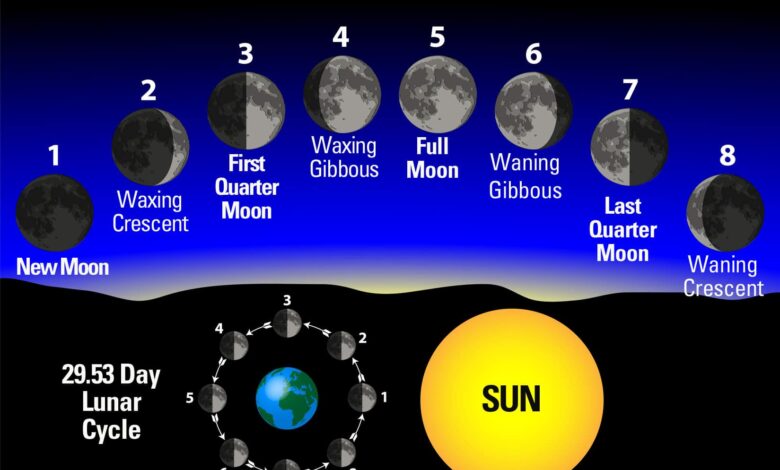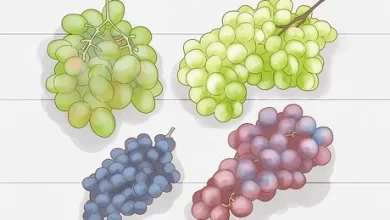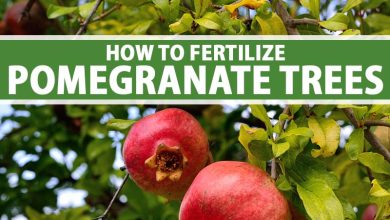Phases of the moon most suitable for each activity in the garden

The gravitational force of the moon influences the sap of plants affecting photosynthesis, the germination of seeds, the movements so that it rises or falls from the roots to the uppermost zone. For example, the phase between the first quarter and the full moon is associated with the maximum point of concentration of sap in the upper zone of the plants; the full moon affects a greater development of the plant in terms of its height, and during the new moon and the waning moon in the roots there is more concentration of sap. It is known that the moon in the ascending position has a greater influence on the sap than in the descending position.
To know if the moon is ascending or descending, we only have to observe it on two successive days. The first day we will observe the moon and we will have a reference regarding its height (for example a building) and the next day, but this time two hours later, we will again observe the height of the moon. If it is lower than the day before then the moon will be in a descending phase and it would be in an ascending phase if the moon were higher.
To identify the phases of the moon is simple. We can distinguish four phases: full moon (the moon is a white circle), new moon (the moon is totally black), last quarter (when the moon forms a C) and first quarter (joining the two points forms the letter D ).
Moon phases and the orchard
full moon
In this phase there may be an increase in pests. In addition, the sap is mainly concentrated in the foliage of the plant, that is why the foliage grows faster, although there is less fruiting than in other lunar phases.
Crescent moon
During this phase the sap rises from the roots to the top of the plant. If you sow during this phase the development will be faster, in particular, the foliage will grow much more than the roots. That is why it would be a good idea to promote their development. It is also more common for plants to be less resistant to diseases or pests.
.
.
New Moon
During this phase it is recommended to carry out tasks such as the control of adventitious, eliminating those plants that we do not want in our garden, in addition we will carry out other maintenance tasks of the crops.
waning moon
During the waning moon we will notice that the plant has more splendor, and so much so that it tends to bear much more fruit. It is a period in which the sap descends towards the roots.
Orchard tasks for each moon phase
Pass:
- For plants with a shallow root, the best time to fertilize is from waxing to full moon.
- If the plants have deep roots, we will pay from last quarter to new moon
Plant reproduction:
- By cuttings and grafts: the stages between the first quarter and the full moon are more beneficial because the cuttings sprout better and as for the grafts, infection problems are avoided and healing is facilitated.
- Germinate seeds: the best times are in the first quarter and the full moon
Irrigation:
If we want to encourage the plants to have more fruits and more flowers, we must restrict watering during the full moon and the first quarter.
Pruning:
To prevent the plant or tree from losing sap, it is recommended to prune during the waning moon. And to make it easier for them to sprout again, it is better to prune between the new moon and the waxing moon. If we want the trees to develop more foliage we will have to prune them at new moon. In cases in which we want to reduce the development of the foliage to favor fruiting, we must prune during the full moon or the last quarter. In general terms, if we want the plants or trees to bear more fruit, we will prune in the first quarter, and if we want to reduce the growth we can in the last quarter.
Spontaneous or unwanted plants:
If we want to eliminate spontaneous plants (badly called weeds), it is better to do it between the full moon and the last quarter.
Sowing:
- The fruit plants or trees are sown in the last quarter, with the exception of those that are gleaned, which are sown in the last quarter.
- The plants or trees that we grow for their flowers or seeds will be sown in the last quarter.
- It is advisable to sow those plants that grow and bear fruit on the earth between the first and the new moon, and between the last quarter and the new moon the plants that bear fruit under the ground.
- The seeds that take the longest to germinate are sown in the last quarter.
- The seeds that germinate soon are sown in a crescent.
Harvest leaves, seeds and flowers:
If we are going to dry them, it is better to take them between the waning moon and the new moon. If they are to be used at the moment, we will take them between the crescent and full moon .
.
.

![Photo of Prune Geraniums: [Importance, Time, Tools, Considerations and Steps]](https://www.complete-gardening.com/wp-content/uploads/2022/08/prune-geraniums-importance-time-tools-considerations-and-steps-390x220.jpg)


